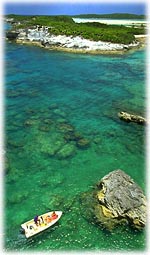
The Bahamas has allocated an additional 58 sites for future development as National Parks, in particular the Andros Barrier Reef, third largest living coral reef in the world, and the Athol Island/Rose Island marine environment.

BEACHES
BICYCLING
CRICKET
DINING
ECO-ADVENTURES
FLYING
GAMING
GOLF
HUNTING
GREEN FLASHES
PARASAILING
SAILING/BOATING
SHOPPING
SNORKELING
SPORT FISHING
TENNIS
WINDSURFING
ECO-ADVENTURES
in the Bahamas
With
over 700 islands and 2,400 cays, the Islands of The Bahamas offer an overwhelming
variety of historical,
cultural, and natural attractions. Although the size of The
Bahamas is traditionally estimated by its land mass (about 5,400
square
miles, including many tiny, uninhabited rocks and isles), these
islands extend over a marine territory of about 100,000 square
miles--almost twice the size of Spain and substantially larger
than Great Britain. This marine territory is as important as
the land mass itself, for while the land provides a place to live,
the sea is a place to play and explore. Most people come to
The Bahamas for its phenomenally clear waters and its abundant and
varied marine life. In fact, almost 5% of the world's coral
reefs
are located here, an amount surpassing even Australia's Great
Barrier Reef. In
addition to the unparalleled diversity of its marine life,
the islands are rich in terrestrial flora and fauna. Because The
Bahamas is an island nation, there are only two indigenous mammals-- the
raccoon and the hutia, an endearing sort of tropical guinea-pig.
Larger mammals introduced during colonization, such as wild
donkeys, wild boars, and horses, do roam in less populous areas--and of
course, whales and dolphins frequent the waters. Reptiles and
amphibians such as the endangered Bahamian rock iguana, the Cat Island terrapin,
and the Hawksbill turtle share the cays and islands of The
Bahamas with the largest nesting colony of West Indian flamingoes in
the
world, as well as nesting colonies of the Bahama parrot. Unique
among New World parrots, the Abaco parrot nests in natural
limestone cavities on the ground. This nesting habit makes the parrot more
vulnerable to predators, especially the wild cats of the Abaco
forests. While the islands of The Bahamas are not lush,
their flora is distinctive, colorful, and varied. Among the Bahamian
plants are the bull vine, whose bright red blooms attract butterflies,
the wild grape, several kinds of fig, and the boldly colored and
shaped bromeliad. There are also wild tamarind and pigeon plum
trees, both of which produce edible fruit, and the ubiquitous casuarina
pine. The various national parks encompass a wide range of environments--from
hardwood forests and whiteland coppices to sand dunes and eerie,
impenetrable mangrove flats. Perhaps because there's
so much to conserve, Bahamians have a strong tradition of appreciating
and protecting
their environs. As a result, the 12 government-funded national
parks of The Bahamas are exceptional. They exist on several islands,
encompassing every kind of habitat that the islands possess and
ranging in size from the tiny gem of Lucayan National Park to the
20,000-acre National Park on Abaco.
Copyright (c) 1995-2013 InterKnowledge Corp. All rights reserved. |